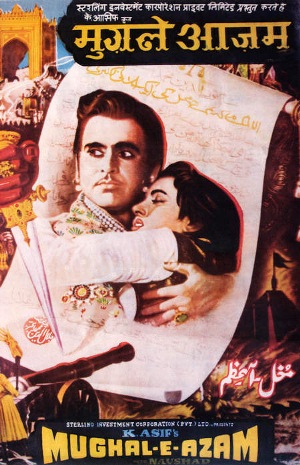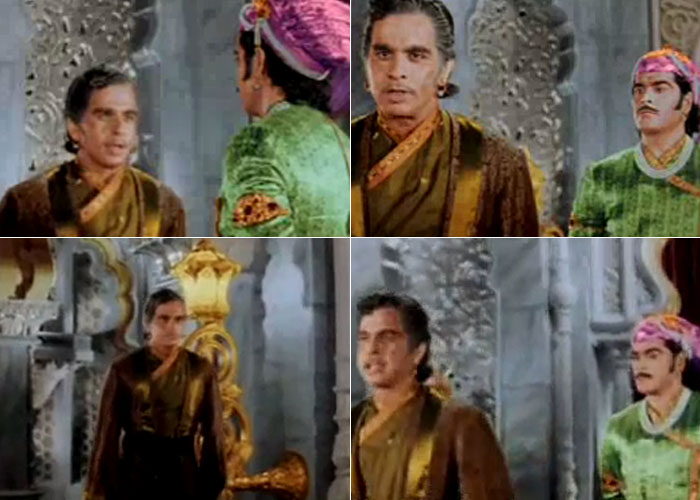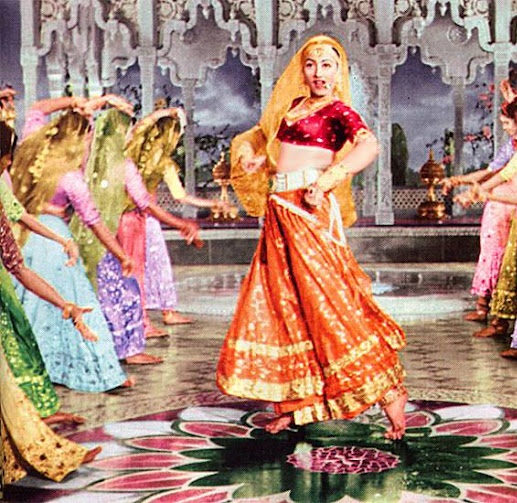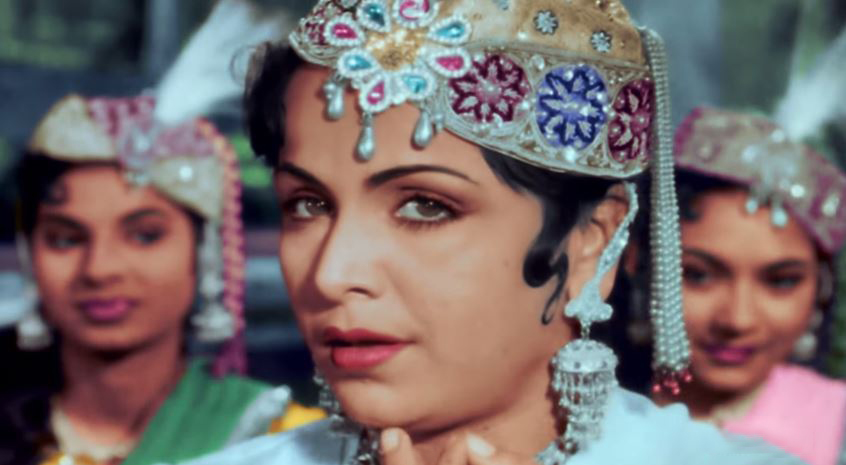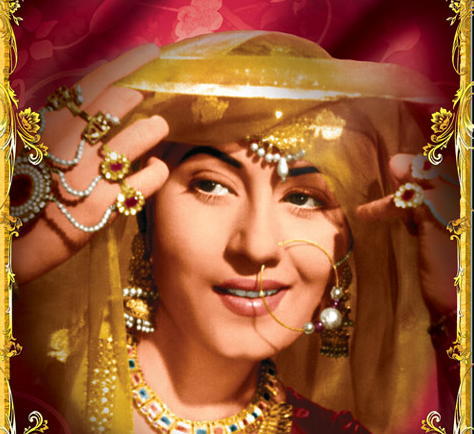
Mughal-E-Azam
Mughal-E-Azam (the Emperor of the Mughals) is a 1960 Bollywood film directed by K. Asif, starring Madhubala, Dilip Kumar and Prithviraj Kapoor. This is one of the most influential Bollywood films of all time and is considered one of the greatest love stories ever told. The grandeur of the film is reflected in every aspect of the film-making, from the huge budget, glorious sets and authentic costumes to the stunning cinematography and art direction.
It explores the themes of love, loyalty, family and war through the tragic love story of the courtesan Anarkali and Mughal prince Salim (who would go on to rule as Jahangir). Mughal-E-Azam had a major influence over Indian cinema and simultaneously spawned many iconic fashion trends that are today considered an integral part of ethnic fashion.
Background
The story of the love affair between the courtly dancer Anarkali and Prince Salim had fascinated Indian film-makers for many years but it was K. Asif who finally managed to bring it to the screen. Many historians discredit the authenticity of the story but it is universally appreciated for its seamless direction, superb cinematography, grand costumes and sets and meticulous attention to detail. Mughal-E-Azam was a huge commercial success too, breaking all box office records at the time of its release. The film was originally shot in black and white with only a few scenes and one song in color. In 2009, the entire movie was colorized, restored and re-released worldwide.
Sources of Inspiration
K. Asif’s vision was to bring to the screen all the majesty and grandeur of the Mughal courts and as such he wanted to make the costumes and jewelry to be as authentic as possible. The costumes in Mughal-E-Azam were directly inspired by the kinds of clothes worn in the Mughal era. From the iconic costumes of Anarkali down to Prince Salim’s slippers, every aspect of the costume design was carefully selected and created to imitate the historical costumes of the period the film was set in. That being said, there were a few modern innovations that were incorporated as a part of necessary cinematic liberties required to create a majestic look on screen.
The Making of the Film
One of greatest contributors to the grand scale of Mughal-E-Azam was the costumes design. A lot of money was spent to ensure that the costumes looked as grand and authentic as possible. Tailors from Delhi, skilled in the art of zardozi embroidery, were brought down to Mumbai to stitch the various Mughal costumes. Specialists from Surat embroidered the costumes with intricate zari and zardozi designs. This kind of attention to detail also extended to other aspects of the costume. Hyderabadi goldsmiths designed the period jewelry while authentic footwear was specially ordered from Agra. Even the crowns worn by the actors were exclusively designed by craftsmen from Kolhapur.
Style and Attires
Most of the primary characters in Mughal-E-Azam are part of the Mughal emperor Akbar’s court and therefore their costumes are appropriately opulent and luxurious looking. The prominent fabrics include fine silks and thick brocades, and most of the costumes are intricately woven and/or embroidered with zardozi or gold thread work. The women’s costumes (especially those of the courtesans) are even more ornate, displaying sparkling diamond embellishments and crystal designs. In the latest colorized version of the movie, the colors are brilliantly displayed and seem to mostly include rich hues of red, blue, purple, pink, green and yellow.
These are a few of the prominent attires from Mughal-E-Azam:
Men’s Costumes
Both Akbar and Salim wore elaborate bagalbandhi costumes with the characteristic side-tying close. In many scenes, Dilip Kumar, who played Salim, is seen wearing a short fitted jacket with a large open front.
Most of the men’s costumes are quite rich looking, with delicate woven designs and a golden luster.
Chaniya/Lehenga Choli
In many of Anarkali’s most famous dance sequences, she is seen wearing a version of the lehenga choli.
This type of clothing to this day is worn by Kathak dancers (which was the type of dance performed by Anarkali). It consists of a long skirt with a wide and circular fall and a short, well-fitted blouse that ends just below the bosom. A transparent net or tissue dupatta completes the outfit. In the song Mohe Panghat Pe the dancers in the background are seen wearing this dress in various colors while Anarkali herself is wearing a red and gold outfit to signify her status as the main dancer. Her rival, Bahaar, is seen wearing similar outfits but in darker, bolder colors like black to signify her ‘villain’ status.
Anarkali Dress
The most iconic of all the costumes from Mughal-E-Azam is probably the gorgeous light blue and red dress worn by Madhubala in the song Jab Pyar Kiya Toh Darna Kya.
A screen grab of the song “Pyar kiya to darna kya” from the movie (Image: http://indiatoday.intoday.in)
This dazzlingly embellished dress is distinguished by its unique cut of a fitted silhouette till the waist with an umbrella-shaped lower half. This type of salwar kameez is today termed the Anarkali because it was her character that truly popularized it.
The anarkali salwar kameez was worn at multiple points in the film but it was the stunning costume worn by Madhubala when she is declaring her love for Salim to the world that has become iconic today. Years after the movie’s initial release, this style of salwar kameez has come to be appreciated universally.
Nigar cap
Also known as the Mughal cap, this unique type of head gear is named after the actress who played Bahaar, Nigar Sultana.
It can be worn by both men and women and is distinguished by its pointed and rectangular shape.
Jodha Bai’s Sarees
The character of Jodha Bai (Salim’s mother) wore a lot of sarees in the movie. These were draped in a distinctive manner, similar to the conservative Rajasthani style of wearing a saree over the head. More subtle than the ornate costumes of Anarkali, these sarees were nevertheless extremely beautiful and elegant in their look.
Character Styling (Accessories, Hair and Makeup)
The other aspects of the look such as the jewelry, the hairstyles and the makeup were also quite distinctive and contributed to the creation of a stunning overall look.
Anarkali wears a lot of heavy Indian jewelry made of gold, as well as authentic Indian styles like Kundan, Meenakari and Polki. She is often seen wearing not just one or two pieces, but a complete set consisting of such pieces as a large hoop-type nose ring (nath), ornate mang-tikka, multiple necklaces, intricate hathkamal, heavy ghungroos (anklets for Kathak dancers studded with bells), ear-cuffs, chokers, kamarbandh (waist chains) and bajubandh (armlets).
Her makeup is carefully done to emphasize the angularity of her face, with arched eyebrows, artistically curled hair and red lips. During her dance performances, her face and hands are covered with alta (henna tattoos) as per the traditions of Kathak dancers.
The jewelry worn by Rani Jodha Bai is also very ornate, though their aesthetics are closer to those worn by Rajasthani nobles of that era.
Present Day Scenario
The anarkali dress has been around for many decades but it was revived and re-popularized with the public only in the mid 60‘s. Today the anarkali is no longer just an iconic movie look; it has become a category of clothing in itself. The anarkali dress is much loved by designers and is frequently seen on red carpets and ramps. The elegant silhouette has been adapted into many different styles, for casual wear as well as formal dressing. Many varieties of the anarkali have taken the international Indian ethnic market by storm, such as the floor length anarkali or the midi-flared anarkali.
The iconic look of the men in the movie with the ornate jackets and churidar pajamas has also become popular formal wear in India today. Known as the Sherwani, it is worn with mojaris or jootis which again were popularized by the characters in the movie.
Trivia
- The most memorable song sequence from the movie, Jab Pyar Kiya Toh Darna Kya, cost 10 lakh rupees to make because the director spent a lot of money on Technicolor in order to truly showcase the colors and beauty of the court and courtly costumes.
- The iconic role of Anarkali is today considered Madhubala’s defining performance but was originally going to be played by Nargis.
References
Categories: Bollywood & Beyond, Indian Cinema

